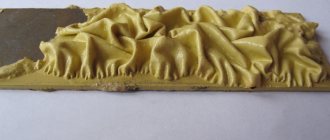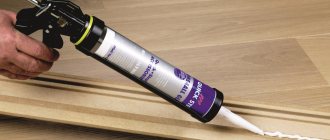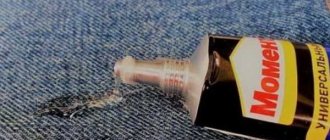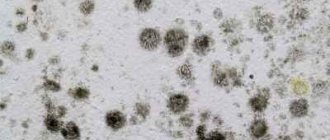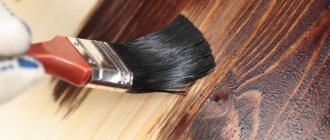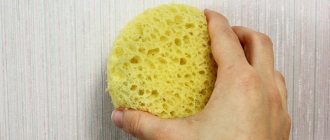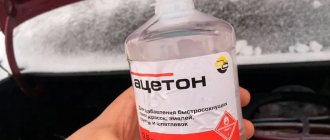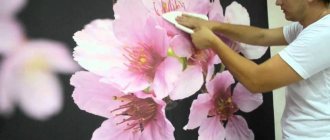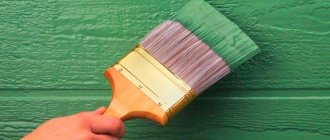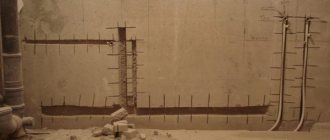By attacking wood, mold spoils its aesthetic appearance. But the main danger of the fungus is not damage to property, but its negative impact on the human body. Spores can provoke an allergic reaction and even cause mycotic pathologies. If the damage is minor, you can remove mold from wood yourself, using antiseptics or improvised means.
Causes of mold formation on wood
Before looking at how to remove mold from wood, it is important to find out why it appears. The first sign that there is fungus in the house is a change in color. A characteristic brown, blue, black, pink or white color appears on the surface of the wood. At first the spots are barely visible. And in the absence of timely treatment, they increase in size and affect large areas of the material.
Some bacteria do not destroy the texture and do not penetrate deep into the wood. But they can ruin the aesthetic appearance of wood trim, floorboards or wall cladding. There are several reasons why fungus appears on wood:
- improperly organized ventilation in the room;
- high humidity;
- sudden temperature changes;
- condensate;
- low-quality wooden material;
- infection of wood by fungi;
- contact with damp soil for a long time.
Mold fungus is dangerous not only because it multiplies quickly, but also because it has a negative impact on people and pets. If you use material contaminated with mold to build or decorate a house, the consequences can be very serious, including the complete dismantling of wooden structures.
Causes of wood destruction
Let's assume that the inside of the house was lined with absolutely healthy boards. However, over time, they also began to turn blue and gradually become covered with ugly stains. What does this come from?
Mold reproduces by spores that are present absolutely everywhere - in the forest, in the fields, on the roads. It is estimated that forest-dwelling species living on living trees cover approximately 40% of the surface area of the trunks and branches of these trees and shrubs. They do not destroy bark and other tissues, but make them more porous.
Spores are easily carried by wind, animals and even shoes. If microorganisms, by any of the listed methods, enter a house where favorable conditions have been created for them, they quickly begin to multiply. The ideal conditions for the existence of mold are high humidity (from 70%) and temperature from +5ºС to +30ºС.
Good ventilation and moderate humidity are two conditions necessary to prevent mold in areas where water is constantly used, such as the bathroom
Wood is just one of the materials on which entire colonies of fungi settle. They can grow on rubble stone, concrete, plaster, paper and even plastic.
Owners of seasonal country houses in central Russia know very well: if you do not regularly heat a wooden house or do not monitor the condition of the basement and foundation, then dark spots will certainly appear in the corners, on the ceiling and even on the furniture.
The same problem threatens cellars and wooden baths if ventilation is not organized in them. Even the interior lining of the clapboard can become infected with fungus and become completely unusable if it does not have the opportunity to ventilate and dry out.
The lack of air circulation also favors the rapid growth of mold colonies. This can be seen in city apartments, where bathrooms are lined with wood panels and ventilation is poor.
If the surface of the panels is not treated with a protective compound, they will soon become covered with a light white or black coating, and over time the cladding will take on a neglected appearance.
Pinotex Base – deep impregnation for the top layer of wood, acts as a primer and antiseptic. Used in combination with decorative products - Pinotex Wood Oil, Pinotex Classic, etc.
Thus, the reasons for the appearance of fungus or mold are the lack of waterproofing, disruptions in ventilation, and high air humidity.
Step-by-step removal of mold in wooden products
Elimination of consequences and prevention of further proliferation of fungal spores is carried out in several stages. How to remove mold from a wooden surface if the problem is found in a neglected state:
- Cleaning damaged areas. You will need a spatula and a chisel. Remove the top layers with a spatula. A chisel and knife are used if damage to the internal structure of the wood is detected.
- Dispose of all removed wood. It is advisable to burn all cut layers of wood.
- Washing the material. Prepare a concentrated solution of laundry soap and carefully treat cleaned wooden surfaces.
- After treatment with soapy water, the wood is allowed to dry. Then they are treated with a wood antiseptic. After disinfection, the wood is allowed to dry and the treatment of problem areas is repeated.
Important! You need to apply an antiseptic not only to areas damaged by mold, but also to areas around it. There may be spores scattered there that have not yet had time to manifest themselves.
Preservation and application of antiseptic
Experts believe that the most effective methods are preservation and coating with an antiseptic.
Canning is the coating of materials with special substances. Such impregnations as:
- diffusion;
- autoclave
As a rule, preservation is carried out in a high-pressure vacuum. This is a special advantage in which this composition penetrates quite deeply.
Treat with an antiseptic - means superficial penetration, which prevents the appearance and proliferation of unwanted substances.
Antiseptic treatment against mold
Methods used when applying antiseptics:
- using a brush;
- using atomizers or sprayers;
- by immersing materials in a specialized antiseptic solution. The solution can be either hot or cold.
Protective compounds used in surface treatment:
- antiseptics;
- various types of paints;
- varnishes
By painting, wood can be protected from moisture, while creating the most aesthetically pleasing appearance for this material. As a rule, for processing material inside a building (in an apartment, for example, or in cellar buildings), you need to use water-soluble paints, and for exterior work - only those made with an organic solvent.
By varnishing wood, you can not only end up with a beautiful matte and glossy finish, but also get a special film that will protect the wooden surface from moisture and fungi, prevent the product from fading and, thanks to it, prevent destruction.
Antiseptics are used most often when the wood is already susceptible to mold.
Types of antiseptics:
- water-soluble products. These products do not adversely affect humans and various animals. They dry quite quickly. You can buy them in two types: there are powder and aqueous solutions. Such solutions are actively used when treating walls, etc. in an apartment and other rooms. But you cannot use this type of antiseptic where the wood comes into direct contact with water.
- another type is water-repellent. They are characterized by significant, compared to the first type, penetration into the wooden structure. These types have a strong odor. They are actively used for baths, saunas, as well as basements and cellars - where the humidity is high.
- antiseptics that are made on the basis of solvents. They are used to treat surfaces both externally and internally on walls, floors, etc. Treatment with this antiseptic dries for up to 12 hours.
- oil products. The main feature of these products is that they must be used on dry surfaces, otherwise the fungus will corrode the wood from the inside.
Use of oil-based wood treatmentsIn this case, a special film is formed on the surface, which protects the desired surface for a long time. Such protective equipment cannot be used in an apartment or other residential premises.
- combined means of protection. They are designed for use in various rooms under any conditions, even for the walls of the cellar and basement. Their main feature is good fire safety.
As they are absorbed, antiseptics are divided:
- for glazing - they are colorless and do not change the color of the surface being coated;
- covering compounds. They penetrate quite deeply, changing the color of the wood.
Antiseptics should also be distinguished by purpose:
- for interior work indoors;
- for outdoor.
For example, paint and varnish antiseptics can be used for exterior work, because they are not negatively affected by external factors. Products intended for work inside are, as a rule, resistant to mechanical influences, but not resistant to ultraviolet radiation and significant temperature changes.
When choosing a means of protecting wood from fungal deposits and mold, you should know the characteristics of each type, and already purchase a product that is suitable for your surface.
Antiseptic treatment of all wooden surfaces
How to clean boards from mold
There are two ways to clean boards from mold: call a specialized service that specializes in removing infected areas or get rid of the fungus yourself. If large-scale wood damage is detected, it is better to use the services of specialists. Since such companies determine the type of disputes and select the most effective means of destruction. In addition, processing is carried out with professional equipment.
If you decide to remove the fungus yourself, a person will need to prepare tools for the work and disinfectants that destroy mold spores.
Why does mold or mildew appear?
Before you understand how to treat wood against mold and mildew, it is worth understanding what conditions contribute to their development on the material. The cause is moisture, we are not only talking about the water that gets on the tree and causes rot and biological formations, but also the percentage of humidity in the environment. The most vulnerable premises are basements, subfloors, cellars where potatoes and other products are stored, etc.
By creating a dry microclimate, the material can dry quickly, which helps increase the tree’s resistance to this damage. And the best way is to ensure a constant flow of air; you should take care of ventilation in the house so that the humidity level does not increase.
The cause of mold is moisture.
How to get rid of mold on a wooden surface
If the material is only slightly affected, the following will help get rid of mold:
- chisel and spatula;
- sandpaper;
- hammer;
- soft rags and fine sandpaper.
The scale of mechanical intervention depends on the depth of penetration of fungal spores. Sometimes it is enough to remove the thin top layer and then perform disinfection without severe damage to the timber.
Antiseptic
A properly selected chemical solution will destroy mold growth areas. As a rule, universal antiseptics and active fungicides are used for these purposes. The following have proven themselves well in the fight against disputes:
- Tikkurila;
- Belinka;
- Neomid.
Important! Any chosen anti-mold product is used strictly according to the instructions. In addition to the recommended dosage, it is important to pay attention to the optimal temperatures at which processing is performed.
We recommend:
How to wash kitchen towels in the microwave
These antiseptics do not contain dangerous chlorine compounds and volatile toxins. At the same time, they are capable of not only destroying areas of bacterial growth, but also subsequently protecting the wood from spores. In addition, there are solutions that additionally have a toning effect. This allows the lumber to retain its natural appearance.
Folk remedies
Before treating the timber against fungus and mold using professional means, you can try traditional methods of combating it. Such means were successfully used for control even before special chemical solutions appeared on the construction market. Among the most popular are the following:
- Acetic acid. Lumber is treated with acetic acid in two stages. Spraying is performed for the first time. After complete drying, wipe again with a dampened rag. This method is completely safe, but gives a short-term effect.
- Hydrogen peroxide. Carefully treat the damaged areas with peroxide and leave for 15 minutes. Then clean the surface with a metal brush. The disadvantages include the risk of losing the appearance of the material.
- Baking soda. Add water to the soda and stir thoroughly until a thick paste is obtained. The product is applied to the damaged areas and left for 30 minutes. Then the surface is cleaned with a stiff brush.
- White. The most effective and most dangerous way to destroy mold fungi. Whiteness is applied to the areas where spores have been identified and left for 15 minutes. Wash off with soap concentrate.
Important! When planning to resort to folk remedies to combat mold, you should not use highly concentrated chlorine solutions. When using such products, you must wear a protective mask and rubber gloves.
Folk remedies are not always effective, and in some cases even dangerous to human health. Therefore, it is better to give preference to modern antifungal drugs with a multicomponent composition.
Professional mold control
There is another effective method for removing an unpleasant “guest” - calling specialists.
They can do things that the residents of the house cannot do on their own:
- will diagnose the microclimate using high-precision instruments;
- analyze the condition of the affected objects;
- will conduct an examination and draw up a conclusion on the nature of the occurrence of mold on wooden surfaces;
- will select the most effective professional products and treat areas of fungal growth with biocides;
- They will neutralize indoor air using UV installations.
If necessary, professionals will carry out construction work: increase the efficiency of ventilation, reduce heat loss by laying insulation, and restore normal humidity by installing waterproofing.
Installing a reliable ventilation system in a wooden house will ensure a normal level of humidity and conditions under which mold cannot develop and destroy the wood.
The main advantage of professional treatment of the room is the guarantee that mold will not bother you in the near future. The most responsible companies undertake to carry out repeated measures to eliminate newly emerging outbreaks.
If you decide to call a team of specialists, take care to document the order. The contract for the provision of services must include a warranty period and indicate a list of procedures performed. If workers carry out construction activities, they must be guided by the requirements of GOST and SanPiN.
How to prevent mold
After disinfection, it is important to take preventive measures. This will not only destroy all mold, but also prevent its occurrence in the future. The rules of prevention are not complicated and consist of the following steps:
- ensuring good air circulation;
- eliminating sources of high humidity. If the house has a basement, regular ventilation and heating will be required;
- maintaining stable temperature;
- annual treatment of wooden facades and finishing with a special antiseptic.
Private wooden houses are most susceptible to mold. Therefore, it is important to avoid mistakes when arranging ventilation, waterproofing and insulation. Since even with modern antiseptics, it is very difficult to completely remove mold. It is much easier to prevent it from appearing.
Rate this post
Features when processing wood surfaces
Thanks to the film that forms on the wood, the coating is reliably protected from moisture and pests. But the problem is that it is difficult to evenly distribute the protective agent over the entire surface due to the unevenness that exists on the wood.
Due to the variety of types of wood, they are impregnated differently.
For example, it is difficult to use antiseptics on coniferous trees; also species such as ash, beech, and birch have a high level of resistance to these agents.
A lot depends on the moisture content of the wood, so you should first dry the material and only then treat it with an antiseptic.
Storage, conservation of material
After drying, it is also important to properly store boards, logs, and timber. These products are distinguished by their tendency to absorb moisture; hardwoods are distinguished by this property. To preserve the material, it is placed in a stack on peppered panels, just like when drying, to create good ventilation of the room.
There are also other ways to preserve wooden products:
- Paraffinization, the paraffin is preheated, then the boards are immersed in it to prevent interaction with moisture;
- Applying heated linseed oil; the wood is placed in the oil for a certain period to ensure a penetrating effect and close the pores with the product.
Such woodworking is only possible with well-dried material; if the moisture has not completely left, it contributes to the appearance of wood fungus.
To preserve the material, it is placed in a stack on peppered panels, just like when drying, to create good ventilation of the room.
Why is fungus dangerous?
The air is constantly filled with fungal spores. Once on the wood, under certain conditions that contribute to the destruction of the tree. The presence of mold on a wood surface leads to the formation of a bluish coating. Mushrooms need tree sap to spread. They develop most actively at temperatures from +20 to 30 degrees, wood humidity above 30 percent
How to choose the right tool and method
The means and method of combating the fungus are selected depending on several parameters. You will need:
- find out what exactly caused the mold to spread;
- determine the type of fungus and strain (sometimes this requires the help of specialized specialists);
- see what kind of wood it is, that is, its moisture level, color, wood markings.
See also
How to fold socks compactly, rules and storage methods
For home use, water-repellent solutions and soluble varnishes against fungus are suitable. Dry rooms - you can choose paint and varnish coatings.
For outdoor work, harsher chemical compounds are used.
But an ordinary person can always determine an effective method of combating fungus. If we are talking about damaged furniture, then as a last resort, you can throw it out and buy a new one. But if the fungus has infected the load-bearing structures of the building, then it is better to leave the work to specialists.
Appeal to professionals
Turning to professionals is an expensive procedure, but it will be 100% effective and will rid your home of the harmful effects of pathogenic microorganisms. This is a whole process that requires preparation. It is carried out according to the algorithm:
- identifying the cause;
- restriction of all furniture and structures from contact with other things;
- ensuring optimal climatic conditions for work;
- complete destruction of mechanical fungus;
- chemical treatment;
- drying and restoration measures, if required;
- coating with antiseptic and varnish.
Of course, the scope of work varies depending on the conditions (outdoors or indoors, the size of the surface being treated), and the type of formation.
Why is mold dangerous?
If wood is exposed to wood staining mold, it can cause discoloration. Such fungi feed on starch contained in wood cells, but do not lead to the destruction of cellulose and lignin. They develop most actively at temperatures from +20 to 30 degrees and wood humidity above 50 percent. Fungi help to increase the water absorption of wood, representing a nutrient medium that leads to the emergence of the most aggressive type.
Substances containing chlorine
The sensational and well-known “Domestos” or “whiteness”, other liquids containing chlorine, also help get rid of the scourge. They need to be applied temporarily to wooden surfaces with a dampened cloth or using a spray. The second option will be of better quality, since the smallest particles will better penetrate into cracks, chips and irregularities. Do not dilute the products with water - the concentrated version will deal with mold better. After some time it will begin to lighten, after which it will disappear completely. Do not wipe the walls; let them dry naturally.
Features of the use of protective compounds
To ensure reliable protection of wood exposed to fungus, care should be taken to evenly distribute the product used. It is important to consider that the wood surface has a complex topography. Achieving a positive result corresponds to the characteristics characteristic of the product (from density to viscosity).
We also must not forget about humidity, the level of which should correspond to a maximum of 30 percent. At a higher degree of humidity, treatment will not lead to a positive result (with the exception of transport antiseptics). It is more difficult for wet wood to absorb antiseptic.
The quality of processing depends on the type of wood (from ash to sycamore, from oak to fir), which is sufficiently resistant to fungal damage. These breeds do not require additional processing. Other species (from linden to hornbeam, from birch to aspen) do not have similar advantages, and the worst absorption of antiseptics is characteristic of coniferous species.
Thanks to protective treatment, it is possible to significantly extend the life of wooden structures.
Special compositions against fungi
In case of severe overgrowth, covering large areas and deep penetration into the wood mass, traditional methods will be powerless.
Products for removing mold and preventing wood protection:
- Tikkurila Homeenpoisto - used to remove moldy deposits from unpainted and painted wooden structures. The composition is applied with a sponge or soft brush in the direction from bottom to top, left for 30-50 minutes, then washed with water from top to bottom. This will help prevent light streaks from appearing.
- Healthy Home Anti-mold is a transparent, colorless, odorless liquid that is used to treat interior and exterior surfaces. Impregnation sterilizes wood, does not change color and texture, and provides long-term preventive protection against damage.
- Alpa Fongifluid is a fungicidal agent for eliminating biological damage and protecting wood. It is used to treat rooms with high humidity (basements, baths, saunas, hotbeds, greenhouses) at any stage of infection. The composition penetrates deep into the fibers without changing the properties of the material and without forming an airtight film.
- Antiseptic Senezh Bio is an aqueous solution of inorganic components for impregnation of wooden products and buildings. The composition actively penetrates into the thickness of the fibers, forming a protective barrier that suppresses the development of fungi and repels wood-boring insects.
- Neomid 600 is a concentrate for preparing a working solution. Quickly removes gray plaque caused by fungal spores and protects the cleaned surface from repeated damage.
- Teknos Rensa Anti-Mold - destroys plaque from overgrown microorganisms on the outside of buildings, works effectively on porous and absorbent materials, and disinfects the surface. Apply the liquid with a brush or spray, do not rinse off, dead and dried vegetation will be removed with sediment.
- Woodmaster Frost bleaching composition is a ready-made solution for cleaning log buildings and products from biological damage. Gently bleaches boards that have darkened over time to their original color, does not impair the strength of the material, and increases its grade.
- Darva impregnation is an antiseptic based on the resin of pine stumps. It is used to protect log buildings from rot, fungal infections, and rottenness. Pine resin is well absorbed and protects the material from aging. The composition can be diluted with linseed oil or turpentine.
- Exterminator Olympus Stop Mold - used to destroy existing mold fungi, rot, mosses and lichens. Creates long-term protection, preserves the original appearance of wood and does not interfere with the natural air exchange of surfaces.
- Belinka is an antifungal aqueous solution for working with heavily infected, absorbent and rough surfaces. Suitable for preventive treatment and destruction of already formed plaque in attics, walls, floors, ceilings, basements and cellars.
Paints and varnishes can be applied over antiseptic compounds. They prevent damage from microorganisms, intense sunlight, moisture and dust.
Traditional methods
People have long come up with various options for protective impregnation of surfaces; the resulting result, its quality and durability will depend on the type of substance and method chosen.
People have long invented various options for protective impregnation of surfaces.
Smiling
The point is the impregnating effect of the resin; it can be replaced with drying oil. The product closes the pores well, thereby cutting off the possibility of moisture getting inside. Growing trees are protected by nature from the appearance of mold and mildew; it is the natural resin that acts as a barrier; depending on the species, the sap of the tree serves as a barrier.
The product closes the pores well, thereby cutting off the possibility of moisture getting inside.
Burning
If you are going to work with coniferous species, then you can use this method. The surface is burned until the surface darkens. After sanding, it is possible to additionally coat the material with varnish or drying oil to enhance the effect. Firing promotes baking of the resin, which ultimately blocks the access to moisture.
Firing promotes baking of the resin, which ultimately blocks the access to moisture.
Surface coating with hot bitumen
Bitumen agents can help get rid of fungal attack; the process itself is identical to the waterproofing method when working with walls and foundations. Due to the danger and complexity of the treatment, this technique is unpopular. Bituminous substances can only be used on the outside of structures.
Bitumen products can help get rid of fungal exposure.
A mixture of vegetable oil and propolis
A similar anti-mold for wood is prepared in an oil to propolis ratio of 3:1. The tool to apply the composition is a brush. As a result, you get a matte, stable layer that is transparent; therefore, it will not be able to cover black or blue stains from fungus. It should be noted that the product increases the fire hazard properties of the material.
The product increases the fire hazard properties of the material.
Application of silicate glue
Silicate-based glue is diluted with water to create a paint-like consistency. The treatment is carried out with a brush or roller; a two-layer coating is required. The result will not protect the surface for a long time, nor will it help against all types of fungus.
Silicate-based glue is diluted with water to create a paint-like consistency.
Soda and vinegar
These affordable means help get rid of existing mold formations and cure the material. First, the surface is covered with soda, then 9 percent vinegar is sprinkled onto it. Because of the resulting reaction, harmful fungi die, and those that were deep in the structure of the tree are also affected. Such exposure is usually enough to ensure that you never see mold on these products again. If the question is asked, how to get rid of fungus in the underground of a wooden house, then the remedy is suitable.
These affordable means help get rid of existing mold formations and cure the material.
Slaked lime
An effective and simple product that can be found on sale ready-made, or you can prepare the product yourself.
An effective and simple product that can be found on sale in a ready-made version.
Treating wood with copper sulfate solution
Copper sulfate is diluted with water, the ratio will be created at the rate of 100 grams of copper sulfate per 10 liters of water. The product is reliable and copes with the task if applied in two layers. But the surface will have a greenish-blue tint; therefore, most often the wooden base is painted afterward.
The product is reliable and copes with the task if applied in two layers.
A mixture of clay and salt
Take clay/water/salt and mix it together in a ratio of 75/20/5. The solution is effective, but is applicable for interior work, or if the facing material will be installed in the future. The product forms a crust that prevents the colonization of wood by insects, etc.
The product forms a crust that prevents insects from colonizing the wood.
Boric acid
To prepare the substance, you need 50 grams of boric acid, a kilogram of salt and hot water. You can apply the prepared solution with a brush or spray.
These recipes are the only possible option when it is necessary to treat the surfaces of baths and saunas, where the use of chemicals is dangerous. It is impossible to use only the tarring method in these structures.
You can apply the prepared solution with a brush or spray.
Kinds
The type of mold determines the choice of method that will help you effectively deal with it forever.
Black
Black mold is the most active and fastest growing of all. It usually destroys the surface quickly. There are several strains that cannot be distinguished from each other without special research.
It is very dangerous for humans, as if it enters the body it causes poisoning and allergies. Fighting black mold is quite difficult - it is not susceptible to most folk and chemical preparations.
Xin
Blue is not so dangerous for the human body, but it causes destruction of structures. Affects fresh and old wood, leading to its rotting. Particularly dangerous for load-bearing structures.
Putrefactive fungus
Putrefactive fungus spreads under conditions of high humidity in the room and the presence of external sources of moisture. Antiseptics and home methods can cope with it.
See also
How to remove an air conditioner from a wall with your own hands during repairs
White
White mold affects not only furniture, but also food. It is easy to deal with, since it is not resistant to aggressive drugs. It does not pose any significant danger to the body.
Top 3 fire-retardant antiseptics
Neomid 450
The domestic company Expertecology produces products under this brand.
NEOMID 450 is considered the best fire retardant for working with wood. Provides 1st and 2nd fire protection groups in accordance with GOST 16363-98.
Important advantages of the product:
- The service life of fire protection when applied in one layer reaches 7 years.
- The validity period of bioprotection against mold, mildew, and insects is up to 10 years.
- There are no toxic substances in the composition, so the drug can be used indoors.
- Sold as a clear, red liquid.
- After processing, the wood can be painted.
- Sold ready to apply. No need to dilute.
- There are no restrictions on application methods or tools.
Fire and bioprotection NEOMID 450
Thanks to this product, wood becomes difficult to ignite.
Excellent for processing:
- rafter systems;
- timber, beams;
- ceilings, logs;
- walls;
- window and door blocks.
Available in plastic canisters of 10 and 30 kg. Price for 10 kg – 1200‒1350 rub.
Senezh Ognebio Prof
Produced in Russia. The quality is not inferior to the previous type.
SENEZH OGNEBIO PROF
Often used for treating boiler rooms. Makes raw materials resistant to fire and moisture. Prevents the formation of mold, blue stains, and damage by bark beetles. Not afraid of temperature changes.
Preserves the original color of the raw material. The mineral composition is quickly absorbed, giving the surface a glossy shine. Color – red, less often pink.
The service life of bioprotection is 20 years. Can be applied in any way, including soaking. Without smell.
The downside is that it costs a lot of money.
Sold in plastic containers of 6, 12, 23 kg.
Price for 5 l - 650 rub.
Wood drying methods
As mentioned earlier, the best way to protect the surface is to dry the wood thoroughly, then it will be least susceptible to biological formations. There are 2 types of material drying:
- The natural method is long lasting. It usually takes 12 months to complete the process, but in the end you can get the opposite result, and the wood will not dry, this is influenced by the drying conditions and the preparedness of the material. The wood must be laid on a lattice base to ensure ventilation on all sides. Each row must have transverse panels to ensure that there are no contacting elements of the material. A film covering is laid on top of the stack, thereby creating air access. It is necessary to create favorable conditions in the room - these are positive temperature indicators, preferably +10-15 degrees, there should be no steam emissions in the room, and also the creation of good ventilation. A rapid increase in temperature is not recommended; such a sudden impact can cause cracks to appear and the wood to bend in different directions;
It usually takes 12 months to complete the process. - Forced drying. This technique is characterized by a fast pace of implementation, typically requiring several days to complete. In this case, it is possible to obtain high-quality wood after drying. But only if the forced drying process is carried out correctly. The technique involves exposing the surface to hot steam for periods; this is done to stabilize the humidity on the surface and inside the product, and to prevent the process of cracks from appearing. They also monitor changes in exposure temperature and change indicators according to a certain pattern.
This technique is characterized by a fast pace of implementation, typically requiring several days to complete.
Drying logs without sanding is not permissible; the bark will not allow moisture to escape, and such an influence will lead to the active spread of microorganisms inside.
Why is wood turning blue dangerous?
Infestation by wood-decaying fungi leads to the destruction of cell walls and bonds between wood fibers. At the same time, its looseness increases, which causes cracking and loss of strength. Such mushrooms can cause the destruction of a wooden house within one year. They develop most actively at temperatures from +18 to 25 degrees, wood humidity over 20 percent.
